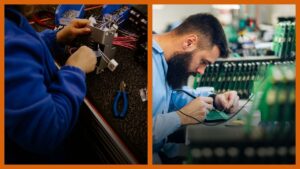Quick Leads-PCBA
If you’re a professional working with PCB assembly or designing IoT devices, understanding multimeter symbols is more than just helpful—it’s essential. Whether you’re dealing with AC voltage, DC voltage, or troubleshooting circuits in high-tech smart home products, these symbols are the key to accurate testing and ensuring your projects succeed. In this guide, we’ll take a deep dive into multimeter symbols, explain their significance, and show how they play a critical role in everything from component testing to smart device reliability.
The most common multimeter symbols include V for voltage, which comes in both AC (V~) and DC (V—) forms, Ω for resistance, and a sound icon for continuity testing. Understanding these symbols is essential for accurately measuring electrical properties in circuits. For instance, V~ measures alternating current voltage, while V— is used for direct current. Mastering these symbols will enhance your efficiency in electrical diagnostics and PCB assembly projects.
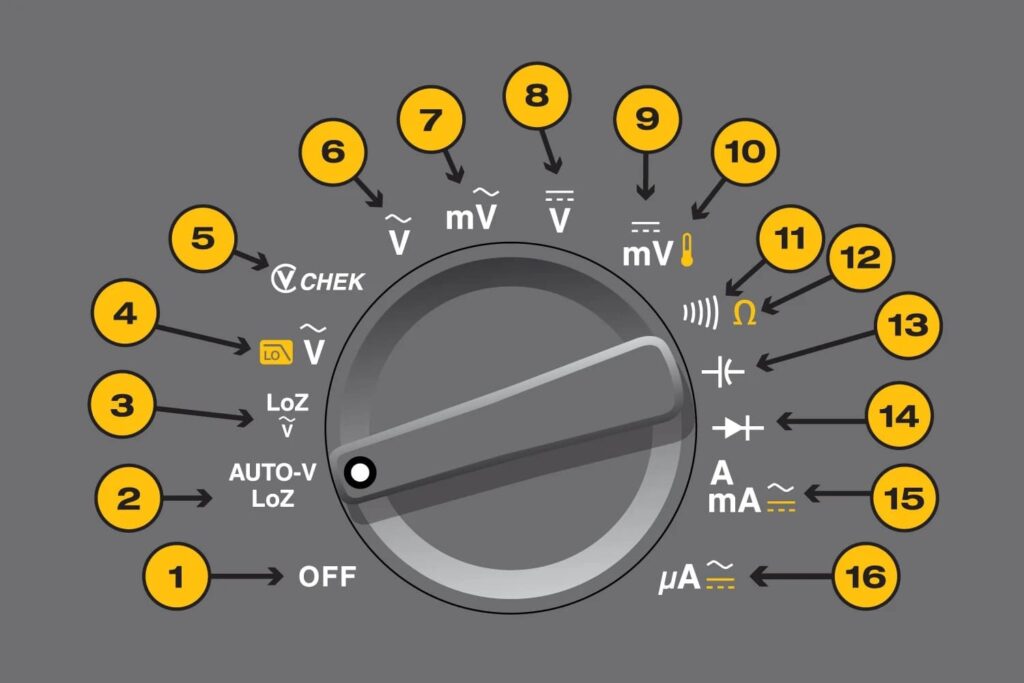
What Does the V ∼ Symbol on the Dvom Stand For?
The V ∼ symbol on a multimeter refers to AC voltage, which is essential for diagnosing electrical systems that use alternating current. This is typically used in household power supplies or industrial IoT devices that require AC. For example, smart thermostats in automated home systems rely on AC power to function, so understanding how to measure AC voltage accurately is crucial.
In a professional setting like PCB assembly, using the wrong setting can lead to inaccurate results, which can cause costly mistakes in product development. It’s especially vital for those working on high-volume IoT products, like Shelly USA’s smart thermostats, which need to operate reliably in homes and buildings.
What Do the Symbols on A Voltage Tester Mean?
When you’re using a voltage tester, you’ll typically see the DC voltage symbol (V—), which indicates that the tester is set to measure direct current. This is important for measuring power sources like batteries, DC circuits, or microcontroller-driven IoT devices. The V— setting helps you ensure that your IoT product is receiving the right amount of power, which directly impacts its performance.
For example, if you’re working with low-voltage sensors in a smart thermostat, the V— setting ensures that you don’t over-voltage components like resistors, which could cause malfunctions in the final product. By understanding the symbols, you’ll avoid issues in PCB testing and ensure accurate results.
Knowing how to use a digital multimeter to test voltage or resistance is crucial when working on IoT projects. A comprehensive guide on how to use a multimeter provides a more detailed breakdown of multimeter usage and tips for accuracy.
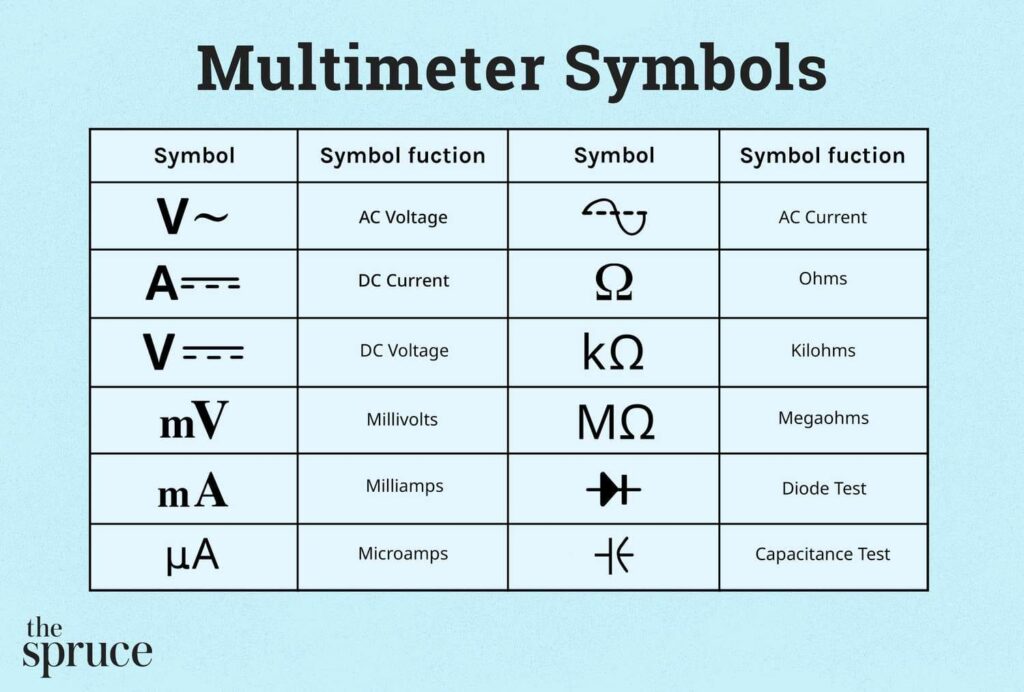
How Do You Know What Setting to Use on A Multimeter?
If you’re new to using a multimeter, figuring out the right setting might seem like a challenge. But once you know the symbols and their uses, it becomes second nature. Here’s a quick breakdown:
- DC voltage (V—): For testing components that use DC power, like IoT devices or batteries.
- AC voltage (V~): For measuring alternating current in circuits.
- Resistance (Ω): Use this when you need to check if there’s continuity or if a circuit is complete.
- Continuity: The sound icon or diode symbol will let you know if there’s a direct path through your circuit, vital for troubleshooting PCBs.
The key is to use the right setting to ensure you’re getting accurate results—especially in high-precision PCB assembly. Misusing these settings could lead to faulty products that end up costing your company valuable time and money.
What Is the Continuity Symbol on a Multimeter?
The continuity symbol, often depicted as a sound wave or diode symbol, indicates that the multimeter is testing for a complete path in your circuit. This is especially useful in PCB assembly when you’re checking for open circuits or short circuits. Using the continuity test ensures that there are no unintentional breaks or connections in your circuit, which can help prevent failures in IoT devices like smart thermostats.
This feature is perfect for troubleshooting mass-produced IoT components that require high precision. It’s one of the key tools you’ll need in ensuring your high-volume assembly lines are running smoothly.
Unit Circuits: Leading PCBA Manufacturer
Limited Time Offer:
Get $100 off your order TODAY!
 ISO-certified & 8+ years of PCBA
ISO-certified & 8+ years of PCBA Low MOQ & Fast Turnaround
Low MOQ & Fast Turnaround Prototype & Mass production
Prototype & Mass production
What Are the Key Multimeter Symbols for DC and AC Voltage?
When working with DC (V—) and AC (V~) voltage, it’s essential to understand the difference in power. DC voltage is constant and is used in most low-voltage IoT devices (such as sensors or microcontrollers), while AC voltage is commonly found in electrical systems in homes or commercial buildings. Accurate measurement of both types of voltage ensures that IoT devices operate efficiently without malfunctioning or overheating.
When working with smart thermostats or similar IoT products, knowing how to properly test both AC and DC voltage can save a lot of time and reduce the risk of assembly errors in your PCB designs.
This blog provides an authoritative explanation on how to read and understand circuit schematics, which is important when working with multimeters in advanced electronics: How to Read and Understand Schematics in Electrical? Basic Symbols Expressions
Comparison Chart: AC vs DC Voltage on a Multimeter
| Parameter | AC Voltage (V~) | DC Voltage (V—) |
|---|---|---|
| Symbol | V~ | V— |
| Power Type | Alternating Current (AC) | Direct Current (DC) |
| Use Case | Household power, industrial | Battery-operated devices, IoT |
| Testing Requirement | Varies in direction and magnitude | Constant, unidirectional |
| Common Applications | Smart thermostats, power grids | Low-power sensors, devices |
How to Interpret Resistance Symbols on a Multimeter?
Resistance is measured in ohms (Ω), and this symbol is used for testing whether a circuit is complete or if a resistor is performing correctly. In PCB assembly, ensuring that your components are properly connected and that there are no short circuits is crucial. If a component is showing too much resistance, it could indicate a malfunction, leading to failures in the final product.
For IoT devices like smart thermostats, proper resistance checks ensure that the circuit boards are functioning within the specified resistance ranges, and helps avoid issues like overheating or current overloads.

What Are the Symbols for Measuring Current?
The current symbols on a multimeter are typically represented by A for amps, and there are variants for measuring milliampere (mA) or microampere (μA). This is especially important for measuring the current draw of components in IoT products like smart thermostats. If you measure too much current, your components could be at risk of overheating, while too little current may mean the device isn’t working as it should.
Accurate current measurements in PCB testing help identify these issues early, ensuring that the final product is safe, efficient, and reliable.
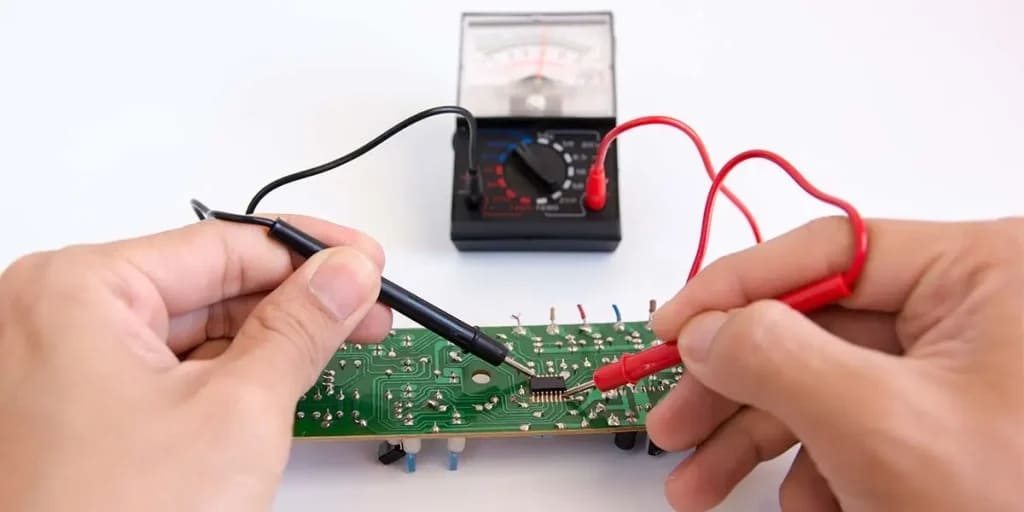
FAQs
Both AC and DC voltage are used in different parts of IoT systems. AC voltage powers components like smart thermostats, while DC voltage is often used in the microelectronics that control them. Ensuring that each is tested properly helps avoid malfunctions and improves product reliability.
The key is selecting the right setting for each test—whether it’s voltage, current, or resistance. For IoT devices, especially in mass production, being precise with these settings can prevent assembly errors and ensure that your products meet safety standards.
The continuity test checks whether there are any breaks or short circuits in a circuit. In PCB assembly, it’s a quick way to confirm that your connections are intact and ready for high-performance devices like smart thermostats.
Yes, but you need to ensure that your multimeter has the appropriate settings for testing DC and AC voltage, current, and resistance. A high-quality multimeter will provide accurate results to avoid errors in IoT product development.
Summary
Understanding multimeter symbols is crucial for engineers, technicians, and decision-makers working with IoT devices and PCB assembly. These symbols aren’t just technical—they play a pivotal role in ensuring the reliability, efficiency, and safety of your products. By mastering these settings, you can streamline the assembly process, reduce testing errors, and ensure that your IoT devices—from smart thermostats to other high-tech gadgets—function as intended in real-world applications.
If you’re working on high-volume PCB projects, especially for IoT products, accurate testing is the key to success. We hope this guide has provided the insights you need to confidently tackle the challenges in your next project.
Have Specific Requirements?
Looking for high-precision PCB assembly for your products? Our team specializes in delivering top-tier assembly services, ensuring your devices perform flawlessly in any environment. Contact us today for a free consultation on how we can enhance your product’s reliability.
Save on your next PCB project?
Claim $100 OFF your order today.
✅ high-quality PCB assembly with strict quality control ✅ ISO-certified & 8+ years of experience. ✅ Low MOQ, fast turnaround, and 100% E-tested PCBs.
Additional Resources:
- How to Repair Circuit Boards: A Step-by-Step Beginner’s Guide
- Capacitor on Circuit Board: A Comprehensive Guide
- What Are PCB Conformal Coatings? Types, Benefits, and Applications Explained
- SMD Size Codes Explained: A Complete Guide to Understanding Surface-Mount Component Dimensions
- AC vs DC: Key Differences, Applications, and Advantages in Modern Electronics
Request for Quote
RECENT POSTS
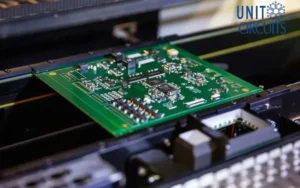
Top 10 EMS Providers Supporting Direct-to-Consumer Shipping (D2C)
Discover top D2C EMS providers offering low MOQ PCB assembly, turnkey manufacturing, and global shipping.
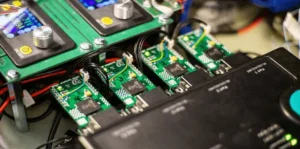
Top 15 Full-Service PCBA Suppliers for OEM Electronics in 2025 [Global List]
Discover 2025’s top full-service PCBA suppliers for OEM electronics. Compare global partners, solve sourcing pain
RELATED POSTS
Leading PCBA Manufacturer
✅ Assemble 20 PCBAS for $0 ✅ Get $100 OFF – Risk-Free Trial!
✅ 100+ Satisfied Customers
✅ Ensured Quality & On-Time Delivery
✅ Free Trial, No Commitments!



